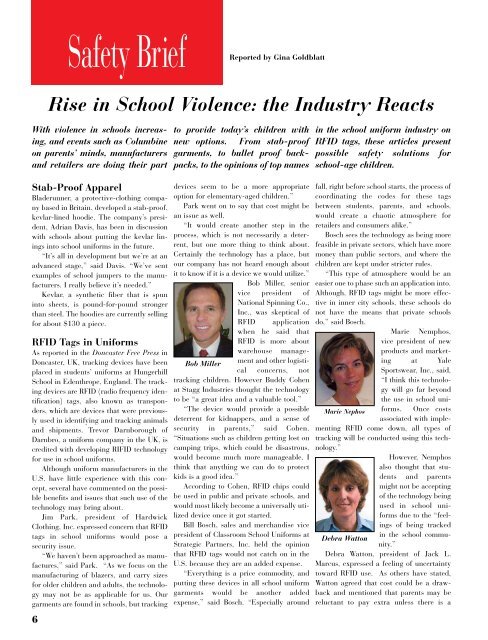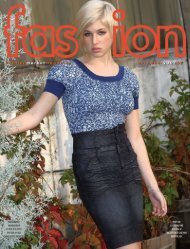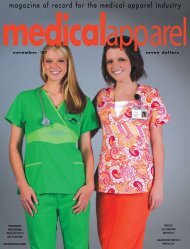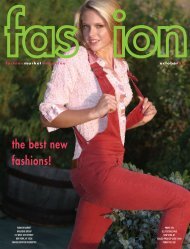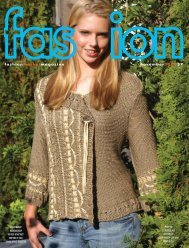Legwear, Outerwear, Blazers, & More - FMMG.com
Legwear, Outerwear, Blazers, & More - FMMG.com
Legwear, Outerwear, Blazers, & More - FMMG.com
Create successful ePaper yourself
Turn your PDF publications into a flip-book with our unique Google optimized e-Paper software.
Stab-Proof Apparel<br />
Bladerunner, a protective-clothing <strong>com</strong>pany<br />
based in Britain, developed a stab-proof,<br />
kevlar-lined hoodie. The <strong>com</strong>pany’s president,<br />
Adrian Davis, has been in discussion<br />
with schools about putting the kevlar linings<br />
into school uniforms in the future.<br />
“It’s all in development but we’re at an<br />
advanced stage,” said Davis. “We’ve sent<br />
examples of school jumpers to the manufacturers.<br />
I really believe it’s needed.”<br />
Kevlar, a synthetic fiber that is spun<br />
into sheets, is pound-for-pound stronger<br />
than steel. The hoodies are currently selling<br />
for about $130 a piece.<br />
RFID Tags in Uniforms<br />
As reported in the Doncaster Free Press in<br />
Doncaster, UK, tracking devices have been<br />
placed in students’ uniforms at Hungerhill<br />
School in Edenthrope, England. The tracking<br />
devices are RFID (radio frequency identification)<br />
tags, also known as transponders,<br />
which are devices that were previously<br />
used in identifying and tracking animals<br />
and shipments. Trevor Darnborough of<br />
Darnbro, a uniform <strong>com</strong>pany in the UK, is<br />
credited with developing RIFID technology<br />
for use in school uniforms.<br />
Although uniform manufacturers in the<br />
U.S. have little experience with this concept,<br />
several have <strong>com</strong>mented on the possible<br />
benefits and issues that such use of the<br />
technology may bring about.<br />
Jim Park, president of Hardwick<br />
Clothing, Inc. expressed concern that RFID<br />
tags in school uniforms would pose a<br />
security issue.<br />
“We haven’t been approached as manufactures,”<br />
said Park. “As we focus on the<br />
manufacturing of blazers, and carry sizes<br />
for older children and adults, the technology<br />
may not be as applicable for us. Our<br />
garments are found in schools, but tracking<br />
6<br />
Safety Brief<br />
Reported by Gina Goldblatt<br />
Rise in School Violence: the Industry Reacts<br />
With violence in schools increasing,<br />
and events such as Columbine<br />
on parents’ minds, manufacturers<br />
and retailers are doing their part<br />
to provide today’s children with<br />
new options. From stab-proof<br />
garments, to bullet proof backpacks,<br />
to the opinions of top names<br />
devices seem to be a more appropriate<br />
option for elementary-aged children.”<br />
Park went on to say that cost might be<br />
an issue as well.<br />
“It would create another step in the<br />
process, which is not necessarily a deterrent,<br />
but one more thing to think about.<br />
Certainly the technology has a place, but<br />
our <strong>com</strong>pany has not heard enough about<br />
it to know if it is a device we would utilize.”<br />
Bob Miller, senior<br />
vice president of<br />
National Spinning Co.,<br />
Inc., was skeptical of<br />
RFID application<br />
when he said that<br />
RFID is more about<br />
warehouse manage-<br />
Bob Miller<br />
ment and other logistical<br />
concerns, not<br />
tracking children. However Buddy Cohen<br />
at Stagg Industries thought the technology<br />
to be “a great idea and a valuable tool.”<br />
“The device would provide a possible<br />
deterrent for kidnappers, and a sense of<br />
security in parents,” said Cohen.<br />
“Situations such as children getting lost on<br />
camping trips, which could be disastrous,<br />
would be<strong>com</strong>e much more manageable. I<br />
think that anything we can do to protect<br />
kids is a good idea.”<br />
According to Cohen, RFID chips could<br />
be used in public and private schools, and<br />
would most likely be<strong>com</strong>e a universally utilized<br />
device once it got started.<br />
Bill Bosch, sales and merchandise vice<br />
president of Classroom School Uniforms at<br />
Strategic Partners, Inc. held the opinion<br />
that RFID tags would not catch on in the<br />
U.S. because they are an added expense.<br />
“Everything is a price <strong>com</strong>modity, and<br />
putting these devices in all school uniform<br />
garments would be another added<br />
expense,” said Bosch. “Especially around<br />
in the school uniform industry on<br />
RFID tags, these articles present<br />
possible safety solutions for<br />
school-age children.<br />
fall, right before school starts, the process of<br />
coordinating the codes for these tags<br />
between students, parents, and schools,<br />
would create a chaotic atmosphere for<br />
retailers and consumers alike.”<br />
Bosch sees the technology as being more<br />
feasible in private sectors, which have more<br />
money than public sectors, and where the<br />
children are kept under stricter rules.<br />
“This type of atmosphere would be an<br />
easier one to phase such an application into.<br />
Although, RFID tags might be more effective<br />
in inner city schools, these schools do<br />
not have the means that private schools<br />
do,” said Bosch.<br />
Marie Nemphos,<br />
vice president of new<br />
products and marketing<br />
at Yale<br />
Sportswear, Inc., said,<br />
“I think this technology<br />
will go far beyond<br />
the use in school uni-<br />
Marie Nephos<br />
forms. Once costs<br />
associated with imple-<br />
menting RFID <strong>com</strong>e down, all types of<br />
tracking will be conducted using this technology.”<br />
However, Nemphos<br />
also thought that students<br />
and parents<br />
might not be accepting<br />
of the technology being<br />
used in school uniforms<br />
due to the “feelings<br />
of being tracked<br />
in the school <strong>com</strong>mu-<br />
Debra Watton<br />
nity.”<br />
Debra Watton, president of Jack L.<br />
Marcus, expressed a feeling of uncertainty<br />
toward RFID use. As others have stated,<br />
Watton agreed that cost could be a drawback<br />
and mentioned that parents may be<br />
reluctant to pay extra unless there is a<br />
demonstrable benefit. Watton also believes<br />
that many problems could arise especially<br />
over over the specifics of tracking students<br />
outside of school. In addition, issues could<br />
arise from the trading or handing down of<br />
tagged uniforms<br />
Donald Singer,<br />
president of Executive<br />
Apparel, while he has<br />
not used RFID tags in<br />
school uniforms, is<br />
open to the idea.<br />
“To date, we have<br />
not gotten too far in<br />
promoting this tech-<br />
Donald Singer<br />
nology for our blazers<br />
or pants, yet we think<br />
the products, monitoring software, and<br />
equipment are out there and reliable,” said<br />
Singer.<br />
Benefits according to Singer<br />
include better security and<br />
inventory control of garments.<br />
“The biggest problem I can<br />
foresee is the cost required to<br />
monitor a large physical area<br />
adequately, although I think this<br />
cost will <strong>com</strong>e down as the technology<br />
improves,” said Singer. “I<br />
love the concept of RFID tags in<br />
uniforms for monitoring the<br />
younger kids. It has a potential<br />
for keeping track of the kids and<br />
the uniforms. This is good, not<br />
only for security purposes but<br />
also for preventing loss of the<br />
uniform itself. I see it as an effective<br />
method for tracking the<br />
locations of kids that<br />
are at high risk for security rea-<br />
sons or adults with behavioral<br />
problems. For older children or<br />
adults, of course, privacy concerns<br />
will always prevail. I<br />
believe the technology has a place, but the<br />
marketplace for it will be quite small. The<br />
accuracy and potential for abuse of the system<br />
is also an issue. These are big problems<br />
to over<strong>com</strong>e before the technology ever<br />
be<strong>com</strong>es mainstream.”<br />
Bulletproof Backpacks<br />
MJ Safety Solutions, a <strong>com</strong>pany founded<br />
by Joe Curran and Mike Pelonzi in<br />
Massachusetts, developed a bulletproof<br />
backpack for school children. They <strong>com</strong>e<br />
in two sizes, one for laptop <strong>com</strong>puters, the<br />
other for books, and both are designed to<br />
protect against an array of weapons including<br />
knives.<br />
“I'm a parent and so is Joe and we<br />
wanted a way of keeping kids safe at school<br />
and this is what we came up with,” said<br />
Pelonzi.<br />
Sandy K. Sroka,<br />
owner of Defensive<br />
Backpacks, which sells<br />
the bulletproof packs<br />
said that the backpacks<br />
are equipped with<br />
heavy duty zippers and<br />
made to last at lease<br />
Sandy Sroka<br />
four to five years.<br />
According to Sroka, the<br />
backpacks weigh about<br />
five pounds, and contain a bulletproof<br />
shield that is not visible from the outside.<br />
“The backpacks have been tested with<br />
nine bullets, being shot from 20 feet<br />
Bullet proof backpacks<br />
by MJ Safety Solutions<br />
away, and<br />
nothing<br />
penetrated the shield,” said Sroka.<br />
The backpacks <strong>com</strong>e in two styles, one<br />
with <strong>com</strong>partments for a water bottle, a<br />
blackberry, and room for books or clothes,<br />
and the other with fewer <strong>com</strong>partments.<br />
The first style <strong>com</strong>es in blue, orange,<br />
and black, and the second style <strong>com</strong>es only<br />
in black.<br />
“Both retail for the same price of $175,”<br />
said Sroka. “The backpacks can be used as<br />
shields, covering children from the head to<br />
the lower back, and if removed and placed<br />
over one’s front, it stretches from the head to<br />
the belt line. Being that the backpacks pass<br />
airline regulations for carry-ons, they are<br />
also very convenient for frequent flyers.”<br />
“MJ Safety solutions has plans to develop<br />
several new models of backpacks,<br />
including a clear bag. Due to the increased<br />
violence in schools in the recent years,<br />
many of them have developed stricter regulations,<br />
some of which have banned backpacks<br />
all together and others only allow<br />
clear backpacks,” said Sroka. She continued<br />
“MJ Safety Solutions is also in the<br />
process of developing camouflage bags for<br />
hunters to add to their already existing<br />
orange backpack option.”<br />
Sroka sells backpacks to customers all<br />
over the U.S., and has plans to expand her<br />
merchandise line to include other school<br />
safety items in the future. In her opinion<br />
the backpacks are “the thing of the<br />
future.”<br />
Sroka went into the business of selling<br />
defensive backpacks as a way to provide<br />
children and parents with a sense of security<br />
in the current atmosphere of heightened<br />
school-related violence.<br />
“I’m not selling paranoia; I’m selling<br />
safety,” Stroka said. “When I was in school,<br />
we couldn’t chew gum, now they are worried<br />
about semi-automatics.”<br />
The MJ Safety Solution backpacks sold<br />
at Defensive Backpacks can be found at<br />
www.defensivebackpacks.<strong>com</strong>.<br />
Trutex UV <strong>Blazers</strong><br />
Trutex, a uniform provider<br />
based out of the United<br />
Kingdom, which supplies<br />
schools all over the world,<br />
developed a UV-protective<br />
blazer. The blazer is not the<br />
first garment the <strong>com</strong>pany<br />
has <strong>com</strong>e out with that has<br />
ultraviolet protection qualities.<br />
For several years now,<br />
Trutex has supplied customers<br />
with sweatshirts and<br />
trousers that protect children from the sun’s<br />
harmful rays.<br />
Trutex’s marketing director, Clare Rix<br />
said, “Sun protection clothing is no longer<br />
restricted to the beach. We’ve been<br />
researching the effects of UV protection<br />
provided by our schoolwear for many years<br />
now and feel it is our responsibility as a<br />
schoolwear supplier to lead the way in safeguarding<br />
the health and well being of the<br />
next generation.”<br />
Trutex garments can be found at<br />
www.trutex.<strong>com</strong>.<br />
SU<br />
7


